

JUDGING BRAHMAN CATTLE
© V8 Ranch, Inc.
All rights reserved. No part of this publication may be reproduced, distributed, or transmitted in any form or by any means, including photocopying or other electronic or mechanical methods, without the prior written permission of V8 Ranch.
office@v8ranch.com www.v8ranch.com
Printed in the United States of America
V8 Ranch, and the V8 brand are registered trademarks in the United States of America and may not be used without permission.
V8 Ranch
P.O. Box 338
Boling, Texas 77420
Telephone: 979-533-2056



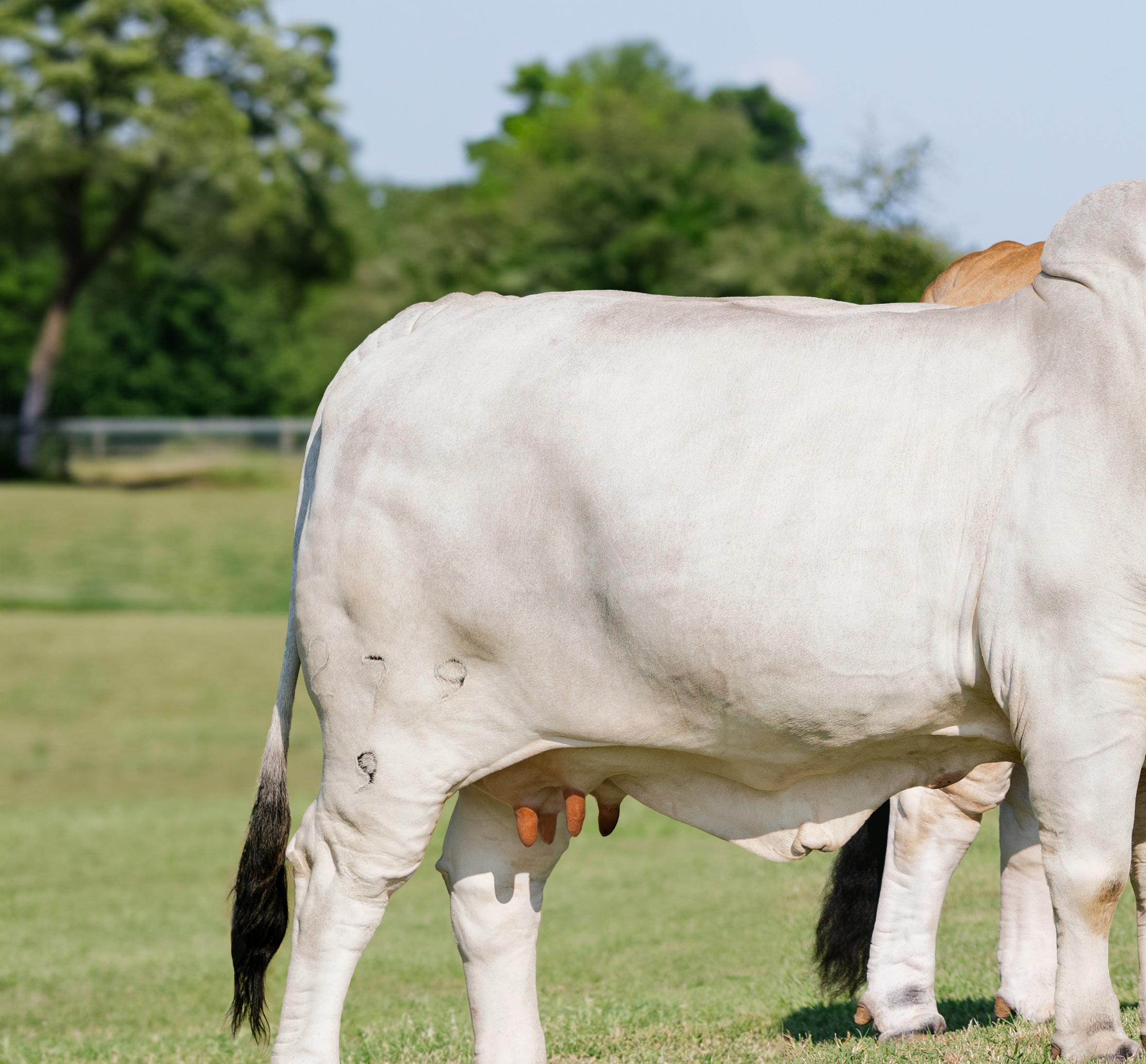
BRAHMAN CATTLE JUDGING
When asked to judge Brahman cattle, many wouldbe judges hesitate for fear that they are not qualified to evaluate this unique and noble breed of cattle. But after a little practice, they usually find that judging Brahman cattle is really no different than judging any type of beef cattle.
Judges should look at the typical traits of structure, muscle, balance, size, and masculine and feminine characteristics that are evaluated in all breeds. From there, judges should take notice of breed-specific traits to use as descriptions and in making final decisions.
THE STANDARD OF EXCELLENCE
Brahman breeders worldwide use guidelines called the Standard of Excellence to visualize what the ideal Brahman looks like. The Standard of Excellence is essentially a score sheet that outlines different traits in a weighted system of importance. Ideally, the perfect animal would have a score of 100 when the final assessment is done.
Standard of Excellence was created by the American Brahman Breeders Association in 1924. Over time, the standards have undergone minor adjustments to accommodate changes in the industry. However, they largely retain the same principles established by the breed's founders over a century ago.
In the United States, judges do not use this scorecard in the ring while selecting their champions. However, in certain foreign countries, some judges still utilize the scorecard, completing one for each animal. These broad guidelines help identify the key areas in Brahman cattle selection. That said, we believe you should always breed what you love, and the magic will follow.
The Standard of Excellence is broken into four categories: general appearance, conformation, breed character, and disposition.General appearance counts for roughly 1/4 of the 100 total points.

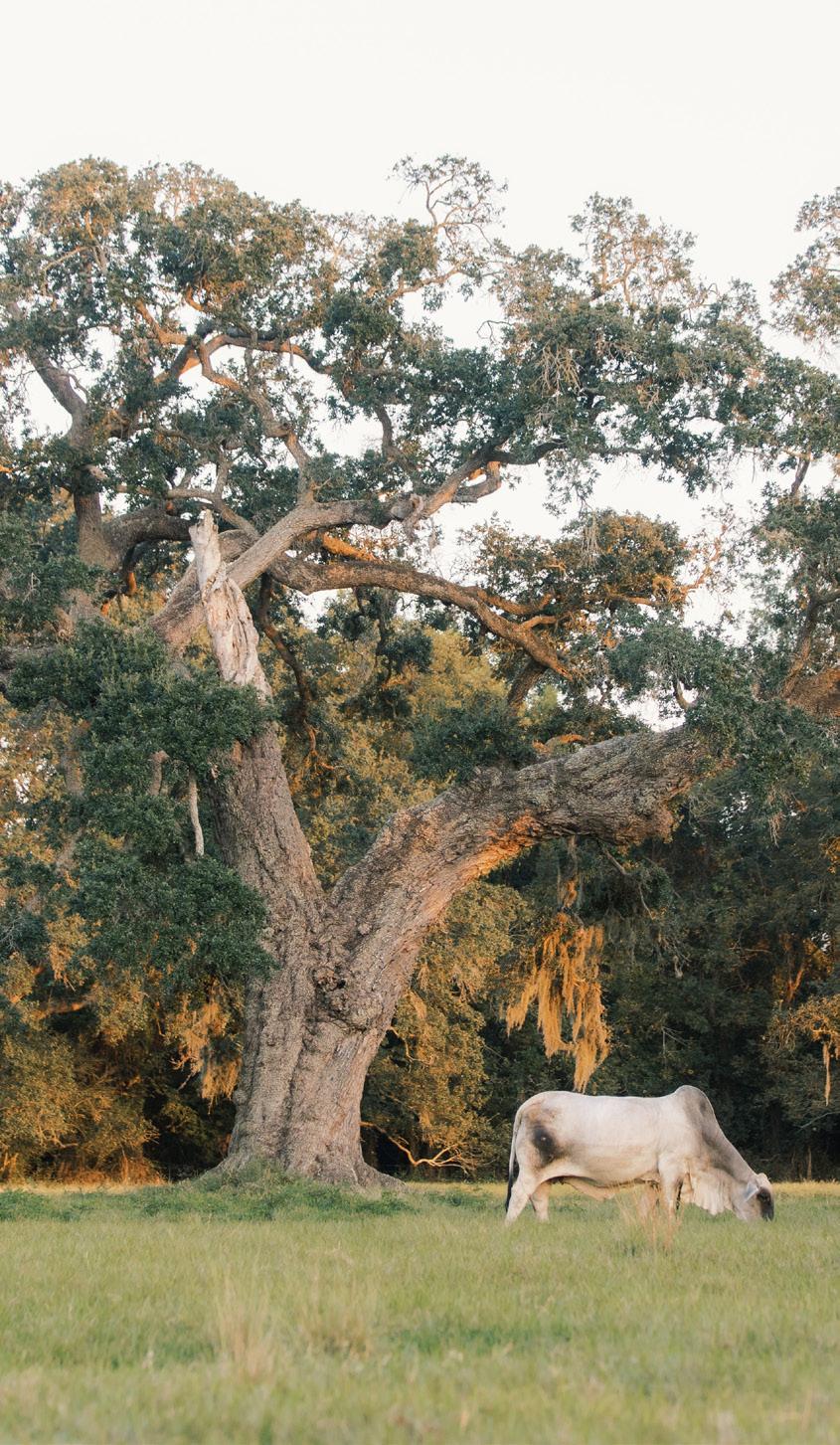
General appearance refers to the overall size, frame, and balance of the animal. Brahman cattle are generally long-bodied, deep-bodied, heavy-boned, and well-balanced. They should have a straight back with a slightly rounded rump.
Conformation makes up over half of the points in the Standard of Excellence, as conformation is one of the most important criteria in judging any beef breed. The ideal Brahman is structurally correct with a smooth, broad top, wide chest, and deep body. It is balanced, bold-sprung, long-bodied, and deep-bodied. Brahmans exhibit a great deal of natural muscling. The hindquarters are long, wide at the pins, and may appear a bit more slightly rounded at the tail head when compared to Bos taurus breeds. However, today’s modern Brahman cattle are usually extremely level-topped and heavy-muscled, so any cattle with steep rump structures would be cause for serious discrimination.
Breed character makes up about 1/4 of total judging points. Breed character addresses color, hump size, hump placement, and sex character. Color is very important in breed character. Brahman cattle are colored grey or red with varying shades of dominance. The nose, hooves, switch, and horns should be black, and this is a requirement for breed registration. Brahman cattle will also have a longer dewlap compared to other breeds. The hump should be of ample size and located directly on top of the shoulders. The sheath and navel will be somewhat looser than Bos taurus cattle but should still be medium-sized and tightly attached. The tail will be moderately long and must have a black switch.
Finally, disposition counts for 6 points. The ideal Brahman should be alert but docile in disposition.
DIFFERENCES NOTICING BREED TYPE
While the predominant traits for judging Brahman cattle are similar to those for judging any beef breed, experienced Brahman judges can discern and differentiate distinct differences in breed type. These special breed characteristics are important to Brahman breeders in both the United States and around the world. By recognizing variations in these breed characteristics, judges can confidently select and describe this magnificent breed of cattle. Remember, breed character counts for nearly one-quarter of the Standard of Excellence, so it should be considered in every judgment.

PIGMENTATION/COLOR
Brahman cattle come in a range of colors, many of which are considered acceptable. The Standard of Excellence describes the colors as “Grey or red of varying shades of predominance.” Many larger shows offer separate breed divisions for Grey and Red Brahman cattle.
Grey cattle can range in color from solid white, light grey, dark grey, redtinged, or “blue.” They may exhibit a snowflake pattern and even be solid black.
Red Brahmans may be cherry red, dark red, varying shades of red, speckled, or red-tinged. They can have varying shades of red to black and more. All of these are acceptable color patterns for ABBA registry.
While the color will differ between each animal — and one is not necessarily better than the other — three specific manifestations will get an immediate disqualification and should be avoided under all circumstances:
• BRINDLE COLORING
• GRUELLA COLORING. A gruella calf may appear mousy or pinkish but will almost always be recognized by a pink or brown nose, light switch, and lack of pigmentation.
• TRUE WHITE OR ALBINO COLORING. These animals would have no pigment anywhere on their body.

It's also critical to check for black pigment in four key spots on the body. All Brahman cattle should have solid black noses, hooves, tail switch, and horns. Judges need to look out for black coloring in these areas. While animals without pigment in one of these spots can still be registered, if pigment is missing in all of these areas, it can affect the animal's evaluation, and that animal will not be registered.
For example, an animal may have a black nose, black horns, and black hooves but have a white tail. While this is far from ideal, and the animal would likely not be shown due to concerns about breed character, it could still be registered with ABBA. It would probably be bred with better-pigmented animals to address the issue in future offspring.
Some Brahman cattle may have black pigment on the tips of their ears and/ or reproductive organs. Pigment in these areas is not a requirement but a personal preference amongst breeders. For example, Australian breeders may prefer Brahman cattle that are solid white in appearance. South American breeders, who often have herds of both red and grey cattle, might prefer a darker-pigmented animal because of the diversity in breeding options.
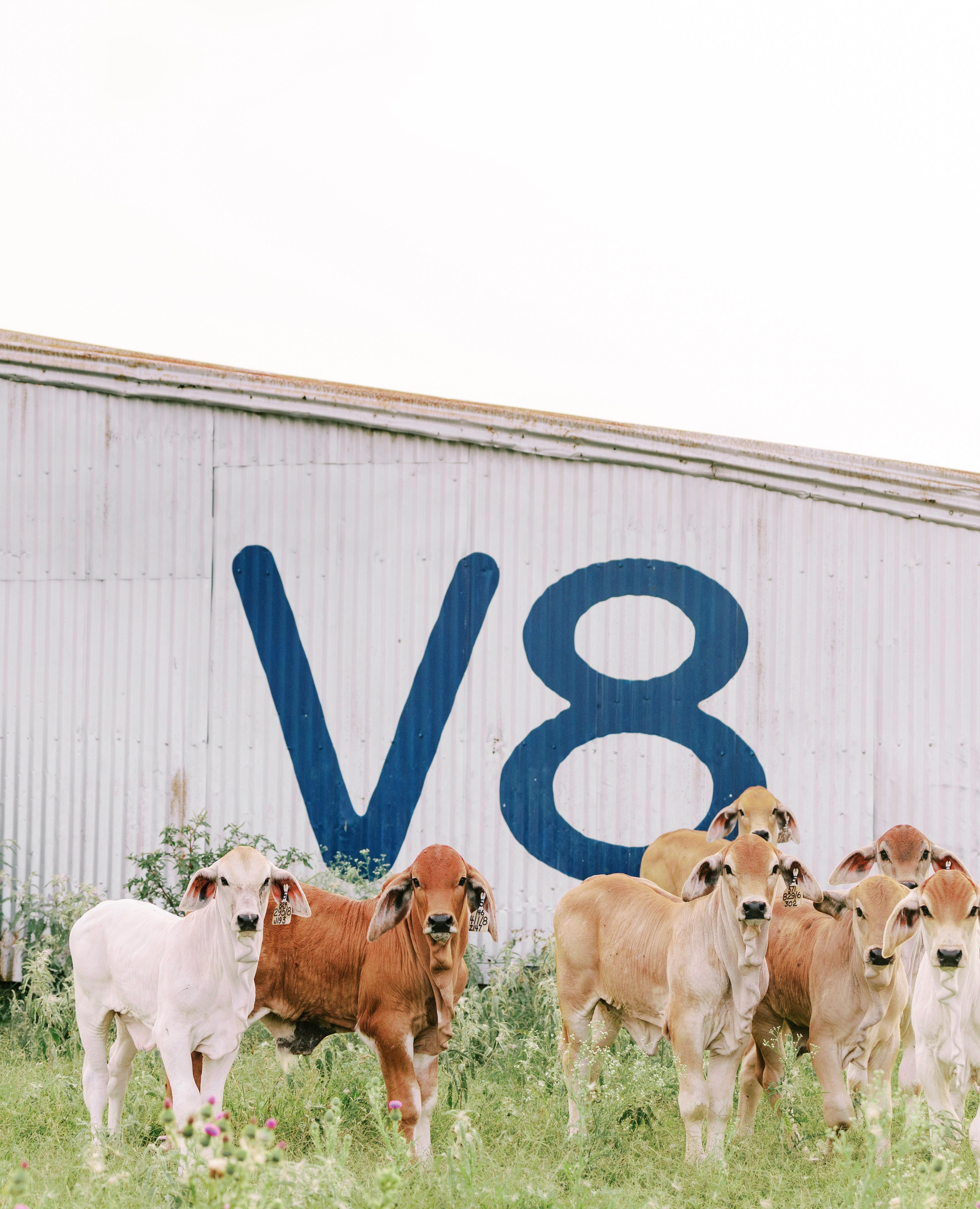

Noting the black-tipped pigmentation is a way to predict how the animal will pass on their color to their offspring. For example, Brahmans with black-tipped ears and black pigment on their reproductive organs can be bred either red or gray — meaning they produce a grey calf when bred to a grey animal or a red calf when bred to a red animal. The black pigmentation offers some diversity in breeding choices.
Among Red Brahman breeders, a deep, dark cherry red is generally considered a more desirable breed character than the lighter pigmented or “pink” color. In ABBA-approved shows, there is a “color committee” that determines whether animals display the appropriate color to be classified as red or grey. A visual appraisal is used first for the animals in question. If needed, the committee refers to the animals' pedigree to classify them
Judges should also keep an eye out for what breeders refer to as “split noses.” This would be used to describe an animal whose nose is half black and half pink. The pigmentation is usually split down the middle, with the black pigment being at the top and then fading to a pink color. Although not a disqualification, this should be a concern and mentioned in the judge's oral reasons.
DIFFERENCES NOTICING BREED TYPE
SHEATHS & NAVELS
The sheath and navel should be medium-sized and closely attached. Judges should expect a slight bit more skin in this area when compared to Bos taurus cattle.
Unfortunately, many judges are not familiar with Brahman cattle and believe all Brahmans have long sheaths and excessive underlines. However, clean underlines and sheaths are very important to Brahman breeders. Just as in any breed, excessively long sheaths or navels are objectionable.
HEAD, EARS, AND HORNS
As with any breed, the animal's sex should be clearly expressed in the head. Bulls should be masculine, and females feminine. The nostrils must be black, and lips dark. Most Brahmans are horned; however, there is an increasing trend toward polled Brahmans.
In Brahman shows, you will find horned and dehorned cattle. Both are acceptable. If horns are present, they should be set wide at the base and black in color. Animals that are scurred (and not surgically dehorned) will display a smaller horn, but the horn should be loose and not attached to the skull. Polled animals often exhibit a distinct polled head shape, which may be more rounded over the skull.
In certain bloodlines of Red Brahman, the head may appear to be larger and more rounded over the skull, and the animal may have ears that are longer and more curved at the tips. This is due to the Gir influence that was used in building the original foundation animals of the Red Brahman breed. The rounded head shape and longer ears are also acceptable and more commonly seen in red cattle than in grey cattle.
DEWLAP & HIDE
Many judges may initially be puzzled by the abundance of skin and loose hide on a Brahman. It is important to understand that this appearance is part of the breed’s well-known heat-tolerant environmental adaptation. The hide of a Brahman will be densely covered with hair that is oily to the touch (after petting a Brahman, you will often notice the oily residue left on your hands). Brahman cattle produce an oily substance from their skin to help cool their bodies during extreme heat. Many breeders prefer animals with looser skin because it allows for better cooling; more skin means improved heat dissipation, particularly in tropical climates.
The skin of a Brahman moves very easily. Interestingly, the Brahman is one of the few breeds that can twitch or shake its own skin. This twitching ability is another environmental breed adaptation trait. By twitching their skin, a Brahman can repel harmful insects and flies.
The dewlap (the skin under the neck and throat) should be well developed with soft, pliable skin arranged in folds from the lower jaw to the chest floor. Bulls will exhibit a heavier dewlap compared to females.
Judges should expect much more skin in general compared to Bos taurus animals. However, do not confuse this skin with fat. Overly conditioned Brahman cattle will still deposit extra fat in their brisket area, which is undesirable in any breed.

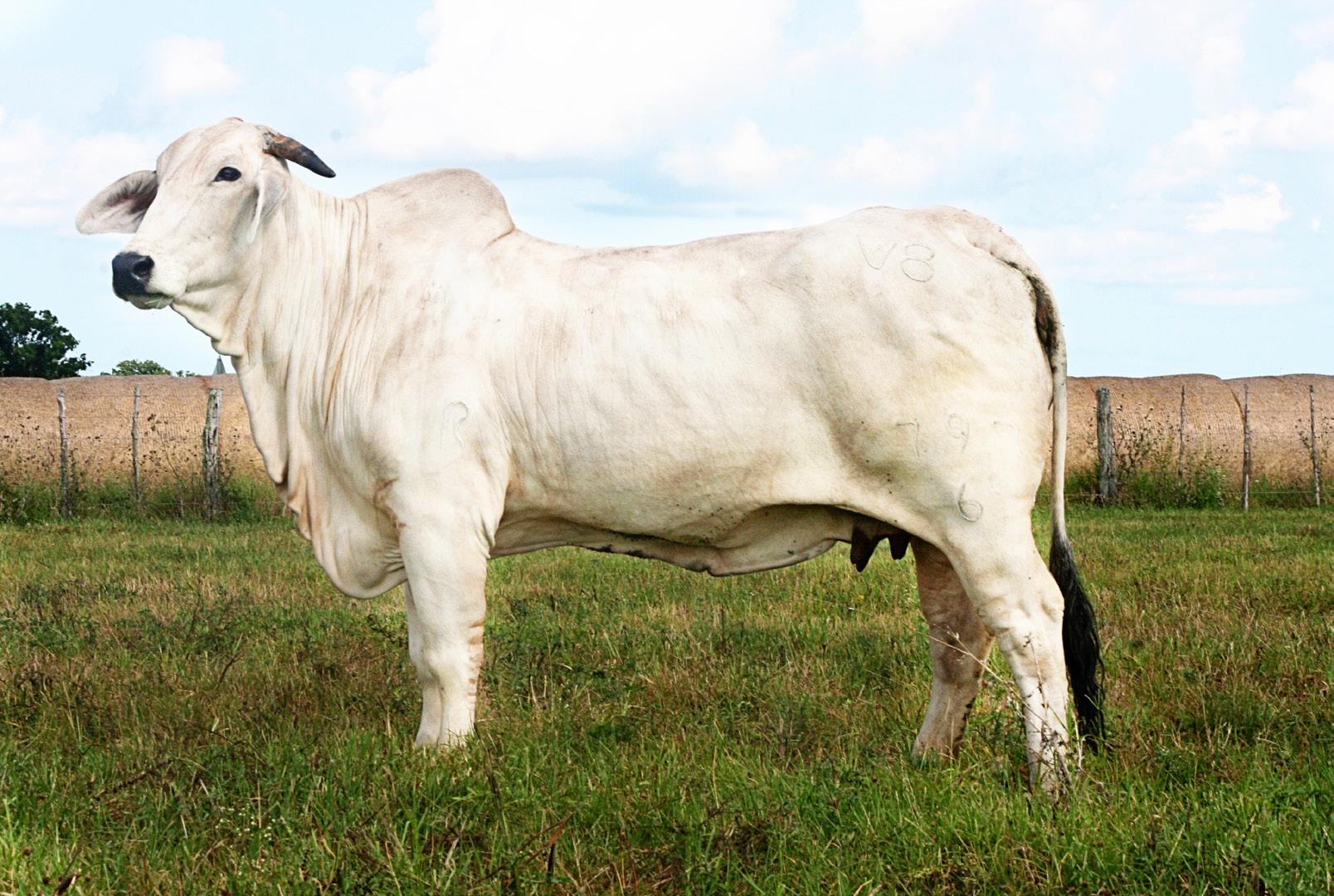
+JDH Sir Avery Manso 159/7, a herd sire at V8 Ranch, is one of the cleanest sheathed bulls in the breed. He also exhibits a typical grey color.
+Miss V8 797/6, an Avery daughter, also displays a very clean underline. This female is also scurred, as shown by her visible horns.

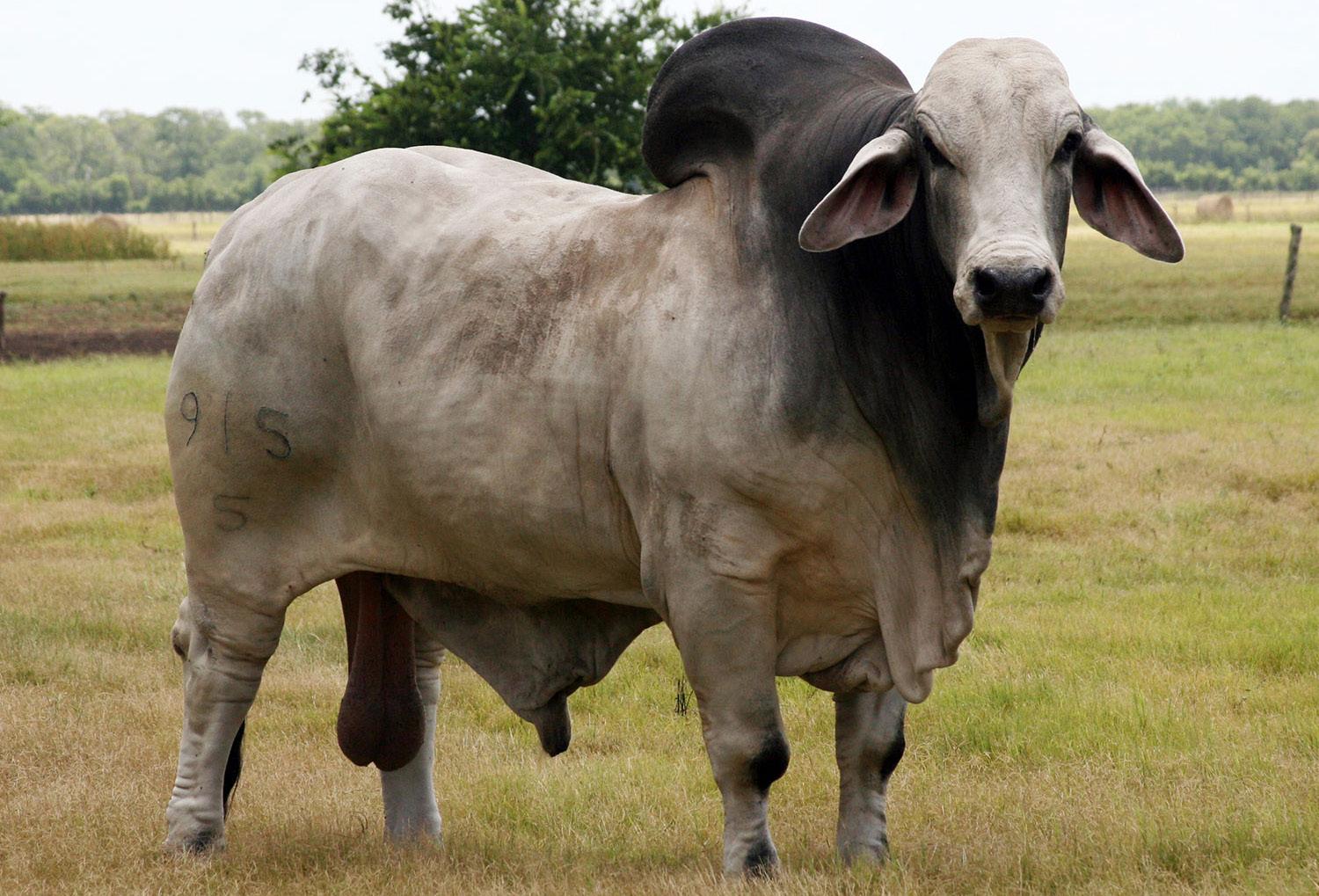
Miss V8 279/9, the 2023 ABBA Show Female of the Year, displays an ideal Brahman female hump. It is of adequate size, oval-shaped, feminine, and properly positioned.
Mr. V8 915/5 displays a very desirable hump for a Brahman bull. The hump is large, masculine, and prominent. The hump is also placed directly over the point of the shoulder.
DIFFERENCES NOTICING BREED TYPE
TAIL
A Brahman’s tail will be moderately long, and generally longer than other breeds. In some cases, the tail switch of a mature bull or cow may even drag the ground. There is no preference for tail shape or length; however, it is crucial to note the black tail switch, which is a requirement. Some foreign breeders prefer longer tails, as they feel it is an indication of the future growth potential of an animal.
HUMP
The Brahman’s signature hump is one of the biggest reasons judges believe evaluating this breed is so unique. In reality, it is not that different from other cattle. According to the Standard of Excellence, hump characteristics only account for 2 out of a possible 100 points. So, while overall judgments should not focus or rely largely on the hump, differences should be observed and acknowledged. In Latin America, especially, the hump and its placement are of utmost importance.
When evaluating Brahman cattle, the most critical factors to consider are the size and placement of the hump. First, the hump should be located directly over the top of the shoulder. It should not be too high on the neck and should stand upright, without leaning to the side. The hump should blend in naturally with the body and be connected smoothly.
A Brahman bull should have a hump of moderate to large size. In fact, many international breeders believe
“the bigger the hump, the better.” A bull’s hump should somewhat resemble a bean in shape and extend backward.
For Brahman females, the hump should be moderately sized—not too small but not nearly as large as a bull’s. A female hump should be more oval in shape and aid in the overall feminine appearance. A female's hump should be refined, compared to a bull’s hump, which would be more coarse and masculine.
BRAND IDENTIFICATION
Brahman cattle are required to display a permanent firebrand to be registered. This requirement includes both the ranch’s holding brand (V8) as well as an individual identification number (287/5). Different breeders use different numbering systems. Some brand on both sides, others only on one side. All are acceptable.
If you're judging a show and encounter a Brahman animal without any branding on its body, this animal should be ranked last and reported to the association. This is because ABBA rules stipulate that "all cattle must be branded" to be shown.
FITTING
Brahman cattle are short-haired American breeds. They are shown with very few fitting products besides show sheen or light oil. The hair should be brushed down and as slick as possible. The tail should hang in its natural state and be neatly combed (not glued).
THE V8 RANCH
STANDARD OF EXCELLENCE STANDARD OF EXCELLENCE

While what we’ve shared thus far comes from ABBA’s Standard of Excellence, many breeders have their own standards—and V8 is no exception. Think of it like a recipe: You take the foundational elements and add your own spin on it—a little more butter, a little more salt, a dash of paprika. The end result? A classic dish you’ve elevated to your taste and preferences.
At V8, we’re always seeking to improve both genotype and phenotype in our animals. So in this next section, you’ll get a glimpse into our “Brahman recipe.”
HEAD: Masculine head at maturity.

JAW/MUZZLE: Good and strong with straight, dark black nose. Correct bite.
NECK: Long and extended.
DEWLAP: Moderate in depth, not heavy fronted or with large brisket.
FEET: Uniform in size, standing square, deep heel.
HUMP: Ample in size, placed directly over the shoulders, even with the front legs. Shaped like a heart cut in two.
TOP LINE: Broad and level with a lot of length.
HEART GIRTH: Full and smooth with a level top behind the hump.
VOLUME: Deep ribbed with good shape and spring. Capacious.
SHEATH:
Moderate in length with good angle and slope.
RUMP/PINS: Long and level from hooks to pins with width at the pins.
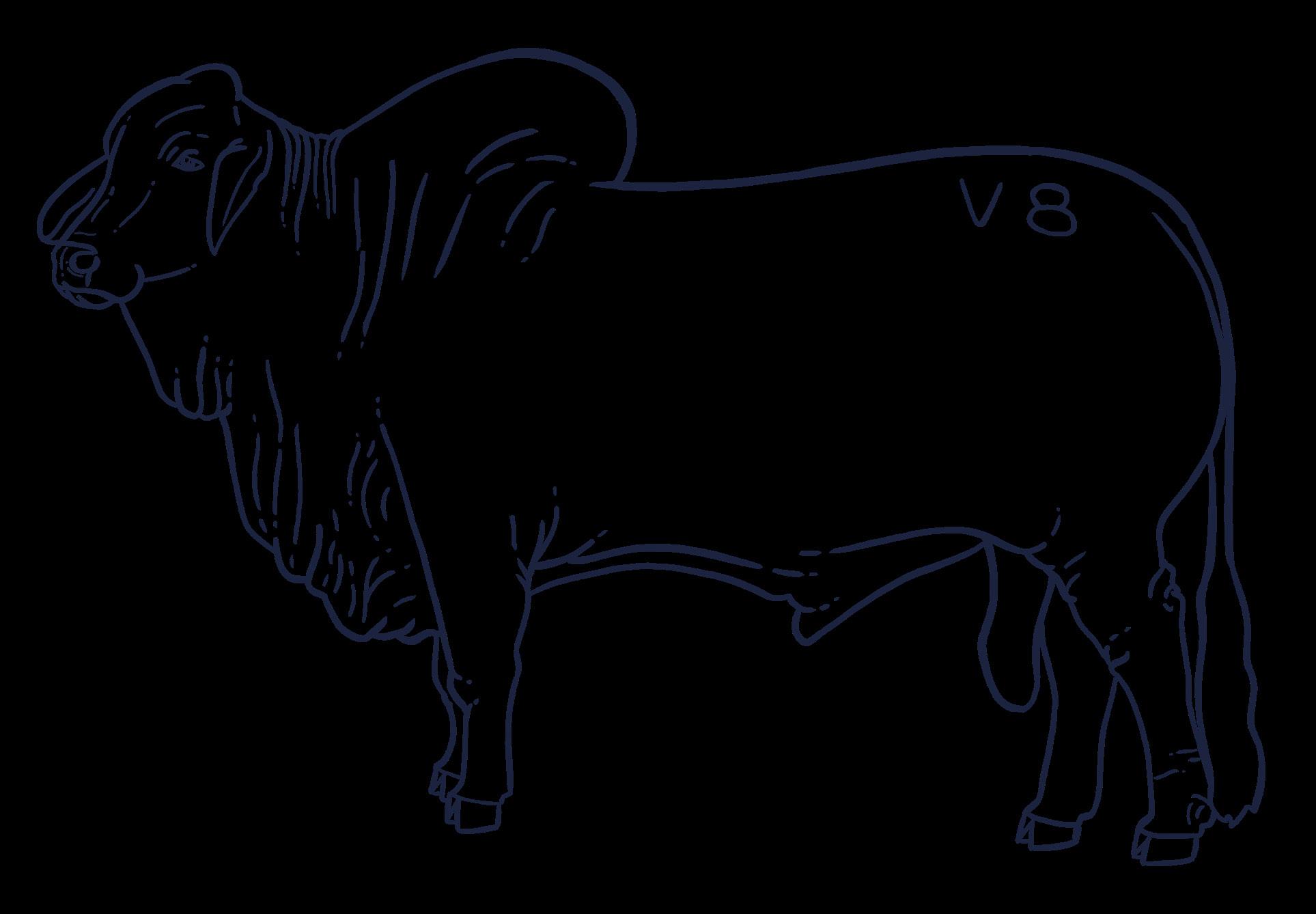
HEAD: Feminine, with a natural slope towards the poll.
NECK: Long and extended.
TESTICLES: Ample in size, symmetrical.
BALANCE: Deep and level from the side. Uniform in length, width, and height.
HINDQUARTER:
Muscular with a lot of development in stifle, deep in the twist and flank.
TAIL & SWITCH: Neatly attached to the body and spine with a long black switch.
JAW/MUZZLE: Good and strong with straight, dark black nose. Correct bite.
DEWLAP: Moderate in depth, not heavy fronted or with large brisket.
HUMP: Ample in size, placed directly over the shoulders, even with the front legs. Shaped like a heart cut in two.
TOP LINE: Broad and level with a lot of length.
HEART GIRTH: Full and smooth with a level top behind the hump.
VOLUME: Deep ribbed with good shape and spring. Capacious.
UNDERLINE: Moderate to tight, free of pendulous excess skin.
FEET:
LEGS: Nice angle to hock, squarely placed.
PASTERNS: A little slope with some flex while walking.
HINDQUARTER:
Muscular with a lot of development in stifle, deep flanked.
UDDER: Held close to the body, balanced, uniform small teats. Ample milk.

Uniform in size, standing square, deep heel.
BALANCE: Deep and level from the side. Uniform in length, width, and height.
RUMP/PINS: Long and level from hooks to pins with width at the pins.
TAIL & SWITCH: Neatly attached to the body and spine with a long black switch.
LEGS:
Nice angle to hock, squarely placed.
PASTERNS: A little slope with some flex while walking.
STRUCTURE AND MOVEMENT

At V8 Ranch, we place a strong emphasis on structural correctness and integrity. We want our cattle to walk and travel well with a good length of stride. When viewed while walking away from a judge, an an- imal should show base width. Observable base width in a traveling animal indicates natural thickness and muscle. When viewed while approaching, cattle should be correct on their front legs, too. As Jim says, "A slight outward toeing out doesn't bother me too much; I am far more critical about toeing in because cattle that are pigeon-toed tend to be out at the knee as well as the shoulders."
When traveling, cattle should also demonstrate a smooth length of stride while maintaining a level top and spine. Short strides indicate structural problems that interfere with longevity. When an animal is on the move, its topline should stay level and not raise up or roach in the middle. Roaching is indicative of a structure problem originating at the feet and legs. A steep rump usually indicates a lower pin setting, and causes cattle to be sickle-hocked and travel with their feet up under their body. Poorly structured animals do not have durability and, therefore, have no place in our pastures or yours.
QUALITY ABOVE ALL ELSE.
JIM WILLIAMS
PIGMENTATION / COLOR
At V8, we view pigmentation like ice cream flavors – everybody has a different preference (white, red-tinged, or dark), but it's all ice cream. And we care less about the flavor than about the quality of the ice cream. In other words, quality is our #1 selection criteria. Our pigmentation preference is for a moderately colored animal with a dark black nose and a good, black long switch.
We don't find the following acceptable: a pigment-split nose, as described above; white eyelashes; and white at the top of the tail switch that fades into the black switch.
Once lighter pigmentation issues are eliminated, personal preference comes into play.
At V8, much of our herd has darker pigment because we like that coloring. Red spots or a little bit of speckling are to be expected with darker pigmented cattle sometimes; these variations are part of that darker color pattern. Also, if white pigmentation is the preferred color, you can easily cross darker pigmented animals to a snow white bull that can keep the offspring white. Ultimately, quality matters more to us than pigmentation variation.
+Mr. V8 146/8 has a long stride and keeps a level topline walking.
BRAND IDENTIFICATION
To mark our individual animals, V8 Ranch uses a chronological sequence of numbers based on calving dates. The first V8 animal was branded as 1. Number 2 followed, and we continued sequentially until we reached number 999.
The sequence then followed with branding as 1/1 (read “One over One”), with the bottom number representing the thousands. So, animal 123/4 (“One Twenty-Three over Four”) is the 4,123rd animal born on the ranch. Brahman heifers and Brahman bulls have their own set of numbers, which means there is a Miss V8 123/4 and a Mr. V8 123/4.
As their family grew, Sloan and Mollie Williams wanted to find a way to ensure future generations would be able to continue their heritage as Brahman breeders. Each child born into the Williams family receives the best heifer calf of that year’s calf crop
Sloan and Jim wanted a way to let the children know which cattle were theirs when they drove through the pastures; they settled on shoulder brands, which can now be seen on a number of the ranch’s cattle.
You might see any of the following shoulder brands as you tour the ranch:
C P KESTABLISHED 1983
Signifies Cattle Owned by Catherine Sloan Williams Now Catherine & Luke Neumayr
ESTABLISHED
1997
Signifies Cattle Owned by Payton Sloan Powell Now Payton & Joe Dodge Jessee
ESTABLISHED
2017
Signifies Cattle Owned by Knox Harrison Neumayr
FAMILY MEMBER SHOULDER BRAND
This female has the K brand, which means she is owned by Knox Harrison Neumayr (Catherine Sloan Williams Neumayr's son)


ANIMAL IDENTIFICATION NUMBER
This female, Miss V8 275/9, is the 9,275th female calf born at V8 Ranch RANCH OWNERSHIP BRAND

TECHNOLOGY & STRUCTURE
New technologies, DNA markers, genomics – there are a lot of exciting developments defining the future of Brahman breeding. But it doesn't change the need to breed a durable animal that is sound on its feet and legs and able to live a long life in the pasture. Thus far, there are no scientific markers for identifiable traits like feet and legs. There is an EPD for `stayability,' but that doesn't distill "sound" or "not sound" into a simple scientific question. The goal may be to get more economical cattle that require less maintenance, but the process is not based on absolutes.
Some big cattle are easy-fleshing; so are some little cattle. Some little cattle are hard-keeping; so are some big cattle. On the whole, largeframed cattle aren't as easy-doing in the pasture, and smaller-framed cattle don't have as much performance about them.
We believe in building a herd with moderate cattle (and some just a tick larger than moderate), because nature keeps pulling the cattle back down to a smaller frame. That one larger-framed animal can change a generation by improving the frame score one level. Just stay with quality!
MATURITY
At V8, we raise cattle with performance in the long run. We embrace the youthful appearance of our young calves, knowing they will gain more thickness and muscle with maturity. As calves, their heights and weights may record lower than our competitors, but they have the performance they need at maturity. Typically, too much maturity in a juvenile calf indicates that the animal doesn't have long-term growth potential. V8 Ranch has strong visual parameters for what cattle should look like during each monthly growth stage. For example, one of our National Champion Females, Miss V8 425/5, got the gate at her first show because she didn't show as much condition and maturity as the others in her class. Two years later, at maturity, she was the National Grand Champion in Dallas.



It takes years of experience, and a trained eye, to project how cattle are going to grow. Over time, we have learned which calves will get better as they age, and which ones will work best when young, but lack competitive edge as they mature. Consider two of our sires who were full brothers: Mr. V8 191/7 and Mr. V8 194/7. Both bulls were outstanding, but different in type. As calves, 194/7 would win the class and 191/7 would stand about fourth. But at 18 months, the trend reversed. Whereas 191/7 was overpowering as a mature bull and practically unbeatable, 194/7 consistently placed third or fourth in the class because, with his quicker maturing pattern, he had a more moderate size at maturity. Conversely, Mr. V8 191/7 was a very impressive mature bull; the last time we showed him in Houston, he was named Reserve International Champion.
+MISS V8 33/8
Pictured at different stages of maturity.

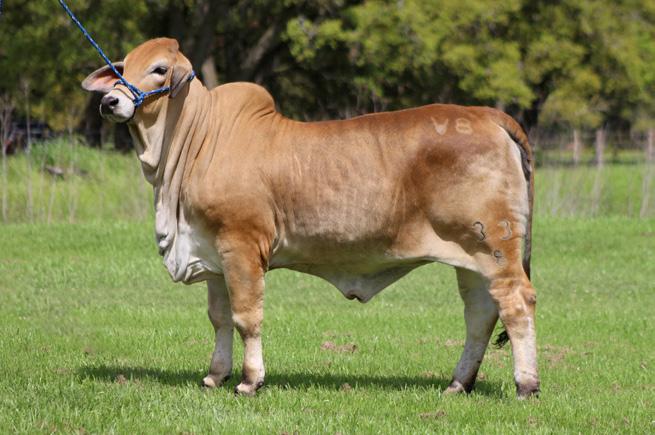

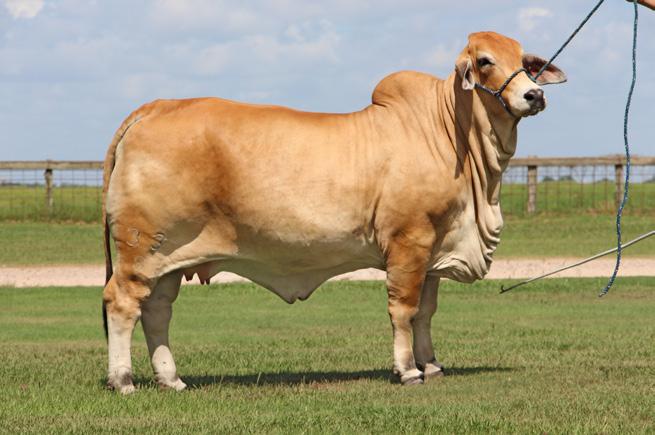
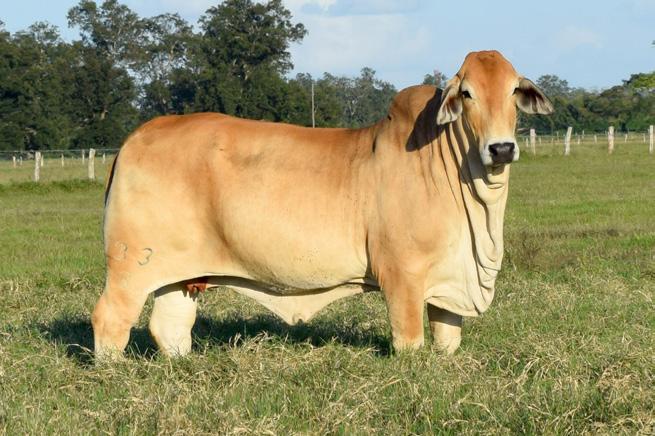
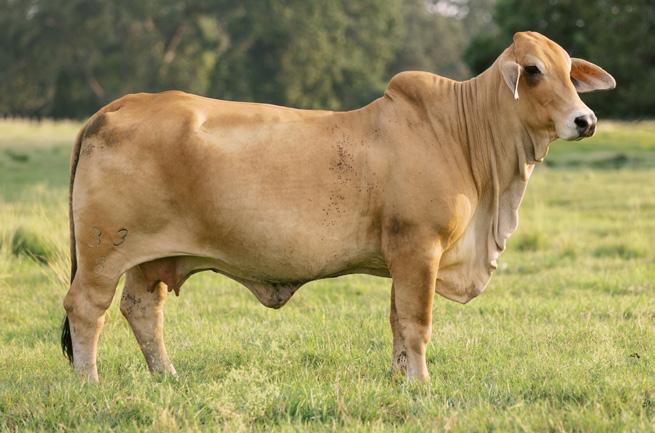
TERMINOLOGY
Every breed of cattle has a certain lingo or jargon that is commonly accepted by breeders, and Brahman is no exception. The following terms are commonly used among breeders:
BLUE OR BLUE-TINGED – Refers to the animal's hide color. A blue animal will be very dark grey, almost black.
RED-TINGED – A primarily grey animal with shades of red, usually over their top line, head and shoulders, or hindquarters. A true “red-tinged” animal must have dark black pigmentation on their ears. A red-tinged animal may also have one or more red spots on their body. Many Mexican breeders do not prefer red-tinge animals with red spots or speckles.
SNOWFLAKE – An animal that is very dark pigmented with a hair coat that expresses random
specks or bursts of grey coloring, creating a ‘snowflake’ like pattern, typically over their hindquarter.
SPECKLED – Brahmans with speckled hide color exhibit numerous spots on their hide. This is more commonly seen in red cattle that may have spots of white and red. Dark-pigmented grey animals will also sometimes have speckled necks.
GRUELLA – An animal with a tan, roan, brindle, mousy hide color that lacks pigment in the areas of the nose, tail switch, and hooves. This animal is extremely undesirable and not eligible to be registered in ABBA. If by chance a gruella is presented at a show, it should be placed last.
SPELLING OF GREY
While the word grey can be spelled either ‘gray’ or ‘grey’ in the dictionary, it should be spelled “grey” when describing a color of Brahman cattle, according to the ABBA Standard of Excellence.
CONCLUSION
Brahman is one of the most significant beef breeds on a worldwide level. They are the #1 beef breed for efficiency, hybrid vigor, and environmental adaptability. The breed's influence is seen throughout herds in North America, South America, Asia, Africa, and Australia, and is extremely useful in commercial crossbreeding. Therefore, a knowledge of modern Brahman breed types is useful for all cattlemen.
For information on our ranch, visit www.v8ranch.com. We also recommend the website www.livestockjudging.com, which features web-based practice judging classes filmed at V8 Ranch.
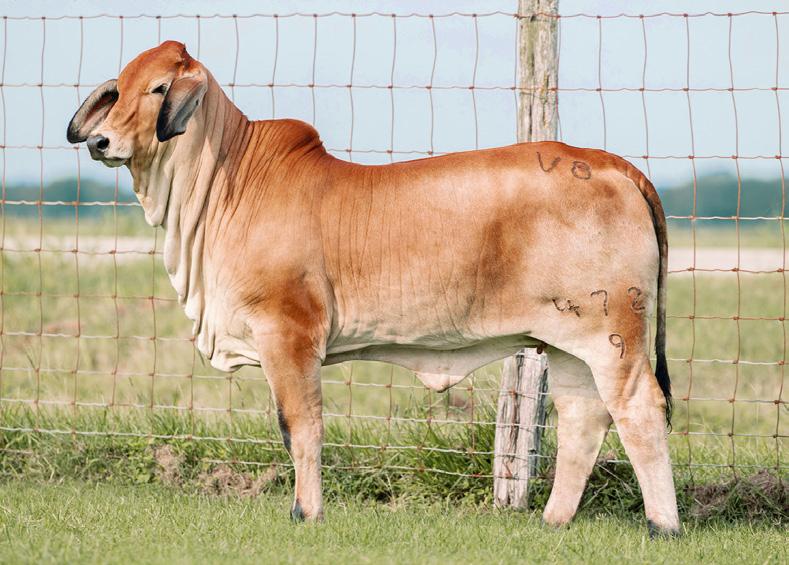
MISS V8 472/9 "MAGIC"
The 2022 Reserve National Champion Female, is a good visual of a female that is “red-tinged” including the black tips.

MR.
Described as a “blue” bull, however, he does not have black pigment on his tips. He was born white and changed to a blue color as he matured.

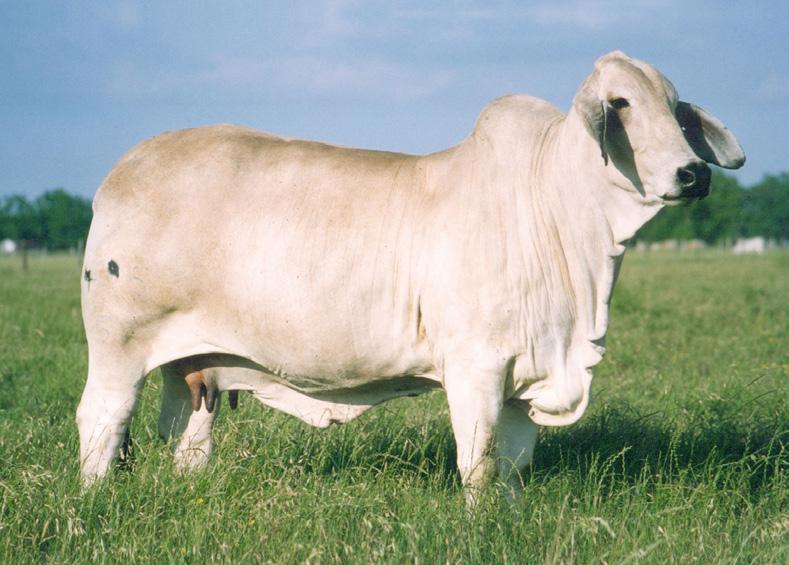

DESCRIPTIVE COLOR EXAMPLES
V8 368/9 "MAGIC MAN"
MR. V8 23/9 "RED ROULETTE" “Red Tinged” bull with black tips.
MISS V8 495/5 "ROSE" Red-tinged female that due to her pigment can be bred to produce either red or grey offspring.
MR. V8 322/8 Snowflake pattern on hindquarter
LIVESTOCK JUDGING WHY IS IMPORTANT?

THE DAY MAY COME WHEN THE ART OF BREEDING CATTLE CAN BE AUTOMATED, BUT TODAY, THE EYE OF THE MASTER STILL PLAYS AN IMPORTANT ROLE IN PEDIGREED LIVESTOCK.
JIM
WILLIAMS, 1988

Since 1944, V8 Ranch has been owned and operated by people who make their living in the cattle industry. Timeless, practical methods are blended with modern management techniques to produce American Brahmans that perform in the pasture, show ring, and beef marketplace. V8 Ranch is proud to have one of the oldest Brahman herds in the United States, having focused on Brahman breeding for over 80 years. Performance and productivity are the foundations of our breeding program. As a result, V8 genetics are known as a dominant bloodline for improving any breeding program.
V8 Ranch is positioned to grow, develop, and adapt to a constantly changing industry. Through selection, meticulously planned matings, and proven management techniques, we continue to elevate our cattle with each generation. Females are chosen by strict guidelines that give equal importance to pedigree, progeny performance, and reproductive traits. Bulls must be structurally sound with an abundance of muscle for optimum and realistic growth, a level smooth loin and topline, desirable sheath, and Brahman breed character. We utilize carcass ultrasound and genetic testing to reveal crucial information on our cattle and to provide as much performance data as possible to our clients.
Only quality breeds quality. Using V8 genetics will improve your herd in one generation. We invite you to visit the ranch and ride through the pastures, where you’ll see some of the finest Brahman cattle in the world. Breeding age bulls and replacement females are available for sale private treaty year round. Semen is also available on many of our leading herd sires.
For more information or to schedule a ranch visit... Call 979-657-2587 or E-mail office@v8ranch.com
A member of our family will be happy to show you around at any time.
The Sloan and Mollie Williams family, taken September 2019 at their Hungerford, Texas Ranch.


